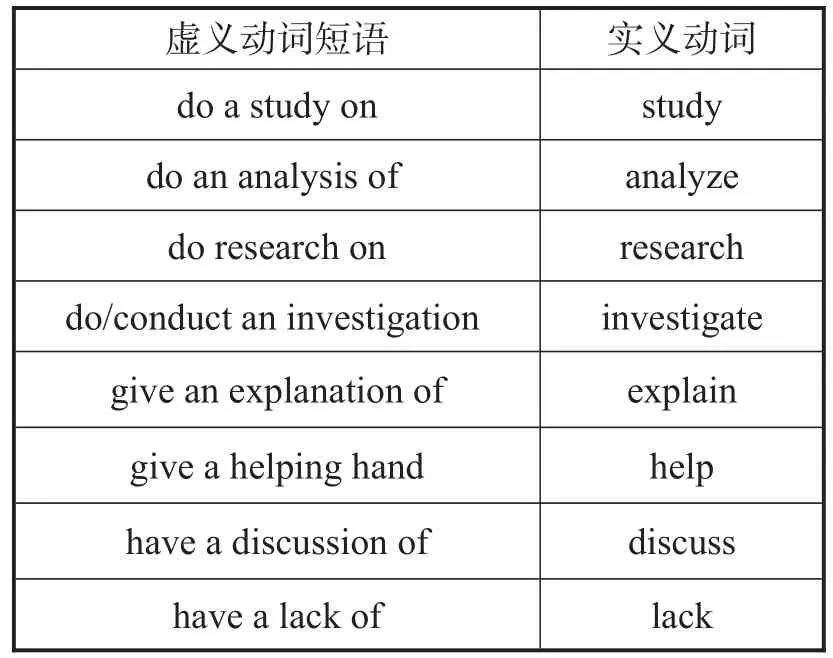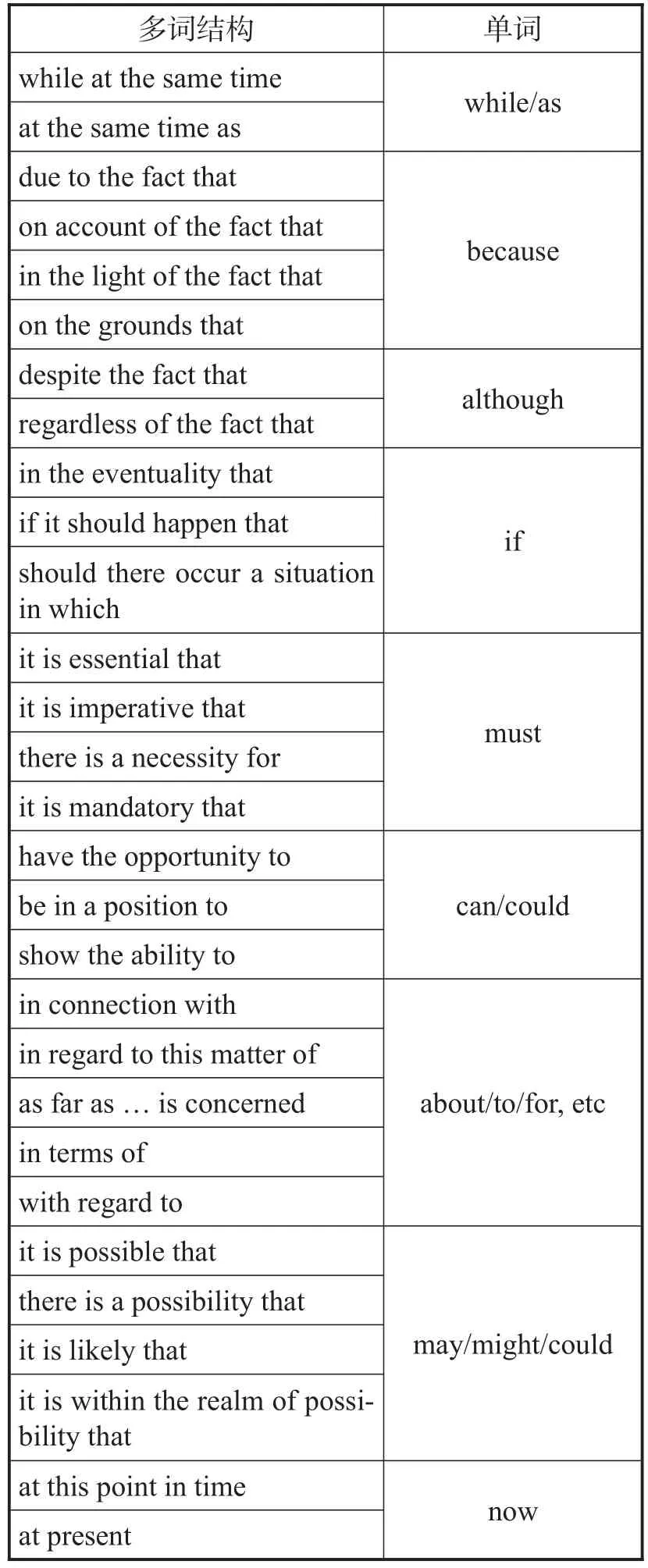英语概要写作中语言简练的秘诀
2019-06-13吕吉尔
□吕吉尔
(宁波市北仑中学,浙江宁波 315800)
概要是一种特殊的文体,其突出特点就是简练。概要写作不仅是用较少的词语把同一件事再说一遍,而且是用尽可能少的词语呈现原文的要旨。因此,概要写作要言简意赅,以最少的笔墨写出最好的表达。概要写作要实现语言简练的目的,诀窍就在于恰当地运用以下一些策略。
一、单词取代短语
(一)实义动词取代虚义动词短语
英语中有些高频动词,因词汇语义弱化而被称为“虚义动词”[1],如 do,get,give,have,make,put等。在这类虚义动词组成的动词短语中,虚义动词本身只表达语法意义,具体的词汇意义则由与其搭配的名词表达,此类虚义动词短语可由短语中表意义的名词相对应的实义动词来代替。表1中左栏为虚义动词短语,右栏为可以替换的实义动词。

表1

续表
在写作概要时,用与此类短语中名词相对应的实义动词取代整个短语,即可在不失句子原意的前提下精简句子,更符合语言简练的要求[2]136。如(例句括号中的内容为画线内容的替代词语,下同):
① Hegaveusanexplanationof(explained)what we were expected to do.
② Some schools lay great emphasis on(emphasize)language study.
③Quickly take a shower(shower)and go!
(二)特定名词取代偏正短语
用一个强有力的名词取代多个虚浮的词语[2]130,即用表示个别、具体概念的特定名词取代一般概念名词与其修饰语构成的短语,同样可使句子简练而又不失原意,且令人印象更加深刻。如:
④Billy,your paper is a true work of art(masterpiece)!
⑤Turn right at the small,wooden house(cabin).
⑥Robert is an extremely smart boy(genius).
(三)单词取代同义叠用短语
意思相同或相近的词或词组重叠使用,称为同义叠用。作为一种修辞手法,同义叠用可使意思更加全面,或起加强语气的作用,但表达必然累赘。如each and every,basic and fundamental,full and complete,feelings and opinions,and so on and so forth等,前后两词或短语意思相同,在写概要时用其中一个即可,以免造成句子冗长而句意未添的弊端。如:
⑦He talked about how much we owed to our parents,our duty to our country and so on and so forth(and so on/etc).
⑧The supervisor sets aside time to dialogue with each and every(every)person in the department once a week.
另有一种现象,虽然不是同义词的直观复现,但实际上语义是重复的,如few(in number),large(in size),period(in time),visible(to the eye),(future)plans,(important)essential,(successful)achievements,(in a)fast(manner)等,均有意义重复之嫌,在写概要时完全可省去括号中的内容。如:
⑨A new comet is now expected to become visible to the unaided eye(visible) later this month.
⑩Such planets or stars are few in number(few)in your creation.
⑪What is the recipe for successful achievement(achievement)?
(四)单词取代多词习语
英语中大量由多词组成的习惯用语和句型结构,也可以通过用同义单词取而代之的方法使句子简化,以达到语言简练的目的。如:
⑫ Despite the fact that(Although) acid rain is destroying Canada’s maples,few people understand the extent of the damage.
⑬The article made several recommendations in connection with(about) the writers’strike.
表2中左栏的多词结构可以由相对应的右栏中的单词取代。

表2
二、短语或单词取代从句
从句往往会使句子变得较长。因此,概要写作中,能不用从句时就尽量不用(当然该用时还得用),而用短语甚至单词取而代之,以达到“概而要”的目的,使概要更加名副其实。如:
⑭If you had not helped me,I could not have passed the physics exam.
→I would have failed in the physics exam but for your help/without your help.
⑮When the sun began to set in the west,we had to wave goodbye to the workers.
→With the sun setting/The sun setting,we had to wave goodbye to the workers.
三、主动语态取代被动语态
被动语态句的词数往往比主动语态句多,因此概要写作中应尽量避免使用被动语态。被动句还可能包含不必要的词语,主动句则可避免此种情况,从而使句子变得更简短,更生动,更有“人情味”——因为主动语态侧重的是动作的行为人。如:
⑯Two months’notice to vacate must be given by the occupant to the landlord.
→An occupant must give the landlord two months’notice to vacate.
⑰It should be noted that the balance of the loan may be paid off at any time.
→The borrower may pay off the balance of the loan anytime.
⑱The photos were loaded onto the PC by Harmony.
→Harmony loaded her photos onto the PC.
四、变换句式以精简句子
同一个意思可用不同种类的句子(如复合句、简单句等)或不同结构的句子(如It is…that…,Either…or…,Neither…nor…,Not only…but also…,Both…and...等)来表达,但用词量会有所不同。一般而言,“直截了当”表达意思的句式相对较为简约,而“拐弯抹角”表达的句式则相对较为冗长。在写概要时,应尽量采用用词相对较少的句式,以使句子“瘦身”而不失原意,达到简练的目的。如:
⑲It is the purpose of this document to summarize the findings of the investigating committee.
→This document summarizes the findings of the investigating committee.
⑳Given that the volunteers are provided with food,they will survive.
→Provided with food,the volunteers will survive.
21He not only writes his own plays,but also acts in them.
→He writes his own plays and acts in them.
22There are several alternatives which should be explored.
→Several alternatives should be explored.
语言简练是概要写作的基本要求,也是确保概要结构紧凑的必要条件。而做到语言简练的诀窍就在于恰当地运用上述策略,用有限的词数完整、充分、准确、客观地表达源文本的主旨和内容要点。□◢
